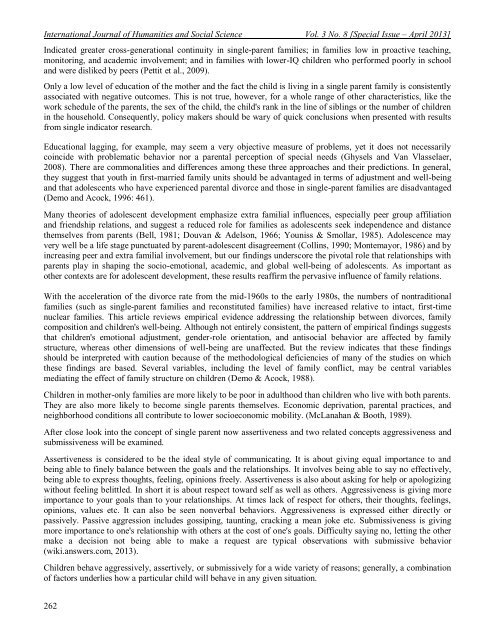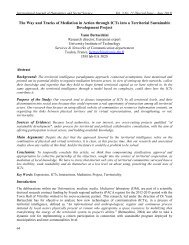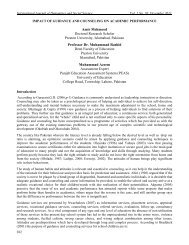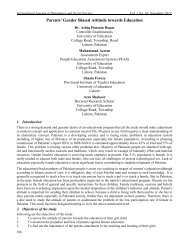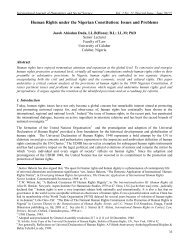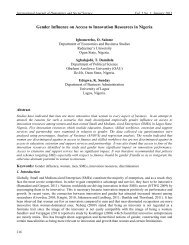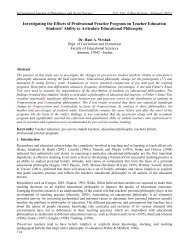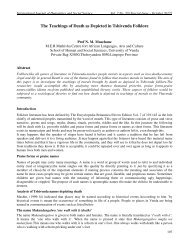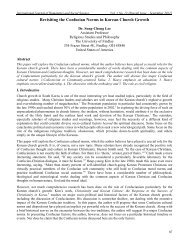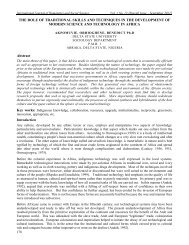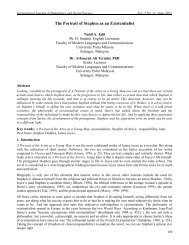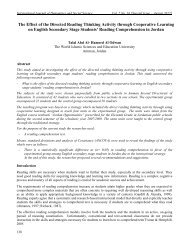Comparison of Single and Two Parents Children in terms of ...
Comparison of Single and Two Parents Children in terms of ...
Comparison of Single and Two Parents Children in terms of ...
You also want an ePaper? Increase the reach of your titles
YUMPU automatically turns print PDFs into web optimized ePapers that Google loves.
International Journal <strong>of</strong> Humanities <strong>and</strong> Social Science Vol. 3 No. 8 [Special Issue – April 2013]<br />
Indicated greater cross-generational cont<strong>in</strong>uity <strong>in</strong> s<strong>in</strong>gle-parent families; <strong>in</strong> families low <strong>in</strong> proactive teach<strong>in</strong>g,<br />
monitor<strong>in</strong>g, <strong>and</strong> academic <strong>in</strong>volvement; <strong>and</strong> <strong>in</strong> families with lower-IQ children who performed poorly <strong>in</strong> school<br />
<strong>and</strong> were disliked by peers (Pettit et al., 2009).<br />
Only a low level <strong>of</strong> education <strong>of</strong> the mother <strong>and</strong> the fact the child is liv<strong>in</strong>g <strong>in</strong> a s<strong>in</strong>gle parent family is consistently<br />
associated with negative outcomes. This is not true, however, for a whole range <strong>of</strong> other characteristics, like the<br />
work schedule <strong>of</strong> the parents, the sex <strong>of</strong> the child, the child's rank <strong>in</strong> the l<strong>in</strong>e <strong>of</strong> sibl<strong>in</strong>gs or the number <strong>of</strong> children<br />
<strong>in</strong> the household. Consequently, policy makers should be wary <strong>of</strong> quick conclusions when presented with results<br />
from s<strong>in</strong>gle <strong>in</strong>dicator research.<br />
Educational lagg<strong>in</strong>g, for example, may seem a very objective measure <strong>of</strong> problems, yet it does not necessarily<br />
co<strong>in</strong>cide with problematic behavior nor a parental perception <strong>of</strong> special needs (Ghysels <strong>and</strong> Van Vlasselaer,<br />
2008). There are commonalities <strong>and</strong> differences among these three approaches <strong>and</strong> their predictions. In general,<br />
they suggest that youth <strong>in</strong> first-married family units should be advantaged <strong>in</strong> <strong>terms</strong> <strong>of</strong> adjustment <strong>and</strong> well-be<strong>in</strong>g<br />
<strong>and</strong> that adolescents who have experienced parental divorce <strong>and</strong> those <strong>in</strong> s<strong>in</strong>gle-parent families are disadvantaged<br />
(Demo <strong>and</strong> Acock, 1996: 461).<br />
Many theories <strong>of</strong> adolescent development emphasize extra familial <strong>in</strong>fluences, especially peer group affiliation<br />
<strong>and</strong> friendship relations, <strong>and</strong> suggest a reduced role for families as adolescents seek <strong>in</strong>dependence <strong>and</strong> distance<br />
themselves from parents (Bell, 1981; Douvan & Adelson, 1966; Youniss & Smollar, 1985). Adolescence may<br />
very well be a life stage punctuated by parent-adolescent disagreement (Coll<strong>in</strong>s, 1990; Montemayor, 1986) <strong>and</strong> by<br />
<strong>in</strong>creas<strong>in</strong>g peer <strong>and</strong> extra familial <strong>in</strong>volvement, but our f<strong>in</strong>d<strong>in</strong>gs underscore the pivotal role that relationships with<br />
parents play <strong>in</strong> shap<strong>in</strong>g the socio-emotional, academic, <strong>and</strong> global well-be<strong>in</strong>g <strong>of</strong> adolescents. As important as<br />
other contexts are for adolescent development, these results reaffirm the pervasive <strong>in</strong>fluence <strong>of</strong> family relations.<br />
With the acceleration <strong>of</strong> the divorce rate from the mid-1960s to the early 1980s, the numbers <strong>of</strong> nontraditional<br />
families (such as s<strong>in</strong>gle-parent families <strong>and</strong> reconstituted families) have <strong>in</strong>creased relative to <strong>in</strong>tact, first-time<br />
nuclear families. This article reviews empirical evidence address<strong>in</strong>g the relationship between divorces, family<br />
composition <strong>and</strong> children's well-be<strong>in</strong>g. Although not entirely consistent, the pattern <strong>of</strong> empirical f<strong>in</strong>d<strong>in</strong>gs suggests<br />
that children's emotional adjustment, gender-role orientation, <strong>and</strong> antisocial behavior are affected by family<br />
structure, whereas other dimensions <strong>of</strong> well-be<strong>in</strong>g are unaffected. But the review <strong>in</strong>dicates that these f<strong>in</strong>d<strong>in</strong>gs<br />
should be <strong>in</strong>terpreted with caution because <strong>of</strong> the methodological deficiencies <strong>of</strong> many <strong>of</strong> the studies on which<br />
these f<strong>in</strong>d<strong>in</strong>gs are based. Several variables, <strong>in</strong>clud<strong>in</strong>g the level <strong>of</strong> family conflict, may be central variables<br />
mediat<strong>in</strong>g the effect <strong>of</strong> family structure on children (Demo & Acock, 1988).<br />
<strong>Children</strong> <strong>in</strong> mother-only families are more likely to be poor <strong>in</strong> adulthood than children who live with both parents.<br />
They are also more likely to become s<strong>in</strong>gle parents themselves. Economic deprivation, parental practices, <strong>and</strong><br />
neighborhood conditions all contribute to lower socioeconomic mobility. (McLanahan & Booth, 1989).<br />
After close look <strong>in</strong>to the concept <strong>of</strong> s<strong>in</strong>gle parent now assertiveness <strong>and</strong> two related concepts aggressiveness <strong>and</strong><br />
submissiveness will be exam<strong>in</strong>ed.<br />
Assertiveness is considered to be the ideal style <strong>of</strong> communicat<strong>in</strong>g. It is about giv<strong>in</strong>g equal importance to <strong>and</strong><br />
be<strong>in</strong>g able to f<strong>in</strong>ely balance between the goals <strong>and</strong> the relationships. It <strong>in</strong>volves be<strong>in</strong>g able to say no effectively,<br />
be<strong>in</strong>g able to express thoughts, feel<strong>in</strong>g, op<strong>in</strong>ions freely. Assertiveness is also about ask<strong>in</strong>g for help or apologiz<strong>in</strong>g<br />
without feel<strong>in</strong>g belittled. In short it is about respect toward self as well as others. Aggressiveness is giv<strong>in</strong>g more<br />
importance to your goals than to your relationships. At times lack <strong>of</strong> respect for others, their thoughts, feel<strong>in</strong>gs,<br />
op<strong>in</strong>ions, values etc. It can also be seen nonverbal behaviors. Aggressiveness is expressed either directly or<br />
passively. Passive aggression <strong>in</strong>cludes gossip<strong>in</strong>g, taunt<strong>in</strong>g, crack<strong>in</strong>g a mean joke etc. Submissiveness is giv<strong>in</strong>g<br />
more importance to one's relationship with others at the cost <strong>of</strong> one's goals. Difficulty say<strong>in</strong>g no, lett<strong>in</strong>g the other<br />
make a decision not be<strong>in</strong>g able to make a request are typical observations with submissive behavior<br />
(wiki.answers.com, 2013).<br />
<strong>Children</strong> behave aggressively, assertively, or submissively for a wide variety <strong>of</strong> reasons; generally, a comb<strong>in</strong>ation<br />
<strong>of</strong> factors underlies how a particular child will behave <strong>in</strong> any given situation.<br />
262


